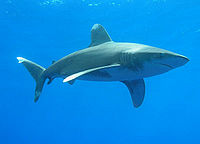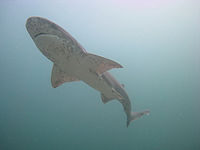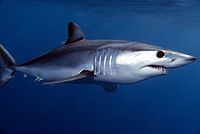Difference between revisions of "Shark"
m (Reverted edits by Apologetic (Talk); changed back to last version by Excalibre) |
DavidB4-bot (Talk | contribs) (clean up) |
||
| (32 intermediate revisions by 13 users not shown) | |||
| Line 1: | Line 1: | ||
| − | + | {{Taxonomy | |
| + | |name=Shark | ||
| + | |image=Oceanic whitetip.jpg | ||
| + | |caption=Oceanic whitetip shark<br/>(''Carcharhinus longimanus'') | ||
| + | |domain=Eukaryota | ||
| + | |kingdom=Animalia | ||
| + | |subkingdom=Biliteria | ||
| + | |branch=Deuterostomia | ||
| + | |superphylum= | ||
| + | |phylum=Chordata | ||
| + | |subphylum=Vertebrata | ||
| + | |infraphylum=Gnathostomata | ||
| + | |microphylum= | ||
| + | |superdivision= | ||
| + | |division= | ||
| + | |subdivision= | ||
| + | |superclass= | ||
| + | |class=Chondrichthyes | ||
| + | |subclass=Elasmobranchii | ||
| + | |infraclass= | ||
| + | |superorder=Selachimorpha | ||
| + | |order= | ||
| + | |suborder= | ||
| + | |infraorder= | ||
| + | |superfamily= | ||
| + | |families= | ||
| + | |family= | ||
| + | |subfamily= | ||
| + | |supertribe= | ||
| + | |tribe= | ||
| + | |subtribe= | ||
| + | |genera= | ||
| + | |genus= | ||
| + | |subgenus= | ||
| + | |species= | ||
| + | |binomialname= | ||
| + | |syn= | ||
| + | |sub= | ||
| + | |alt= | ||
| + | |regionimg= | ||
| + | |pop= | ||
| + | |conservation= | ||
| + | }} | ||
| + | '''Sharks''' are approximately 350 species of cartilaginous fish of the superorder Selachimorpha, inhabiting the world's oceans and several freshwater lakes and rivers. | ||
| − | + | ==Description== | |
| + | Sharks vary in appearance, shape, and size, so there is no absolute description of a typical shark. In general, all sharks with several exceptions share the following characteristics: | ||
| + | ====Cartilaginous skeleton==== | ||
| + | All sharks possess a skeletal system made entirely of cartilage; there is no solid bone anywhere. The vertebrate extends to and forms the upper lobe of the claudal (tail) fin. The skull has no sutures, and in nearly all species the mouth is ventrally-located, i.e. under and behind the snout. The upper jaw is unattached to the skull, enabling the animal to extend both jaws forward to take in prey. | ||
| + | ====Placoid scales==== | ||
| + | Shark skin is covered in thousands of tiny placoid or dentical scales related to teeth; these scales are pointed backward and sharp. | ||
| + | ====Lifetime of teeth==== | ||
| + | The only hard part of a shark's body, their teeth are arranged in a "conveyor belt"-fashion, enabling continual replacement over the lifetime of the animal. | ||
| + | ====Sensory organs==== | ||
| + | [[File:Shark2.jpg|right|200px|thumb|external anatomy of a typical shark]] | ||
| + | Sharks possess several sensory organs which enable them to bear down on their prey or scavenge, often from miles away. Their eyesight is extremely sensitive to light and shadow. Their sense of smell enables them to detect a drop of blood in water a quarter-mile away, while their lateral lines (a nerve line extending along their flanks) enable them to detect the vibrations from distressed fish several miles away. The ''ampullae of Lorenzini'' are small pits on the snout, enabling sharks to detect weak electrical signals produced by the muscle contractions of bony fish. | ||
| − | == | + | ==Diet== |
| − | + | With the exception of the two largest sharks - the plankton-feeding [[Whale shark|whale]] and [[Basking shark|basking]] sharks - all sharks are predatory. Most species eat fish; some, such as the bullhead sharks, eat shellfish. One species ([[Great white shark|great white]]) routinely eats warm-blooded prey. And nearly all sharks scavenge dead remains found anywhere, in effect cleaning up the area quickly. | |
| − | + | ||
| − | + | ||
| − | + | ||
| − | + | ||
| − | + | ||
| − | + | ||
| − | + | ||
| − | + | ||
| − | + | ||
| − | + | ||
| − | + | ||
| − | + | ||
| − | + | ||
| − | + | ||
| − | + | ||
| − | + | ||
| − | + | ||
| − | + | ||
| − | + | ||
| − | + | ||
| − | + | ||
| − | + | ||
| − | + | ||
| − | + | ||
| − | + | ||
| + | ==Behavior== | ||
Many species of sharks give birth to a few dozen live young, others lay a similarly small number of eggs; these are often washed ashore and are known as [[mermaid]]'s purses. | Many species of sharks give birth to a few dozen live young, others lay a similarly small number of eggs; these are often washed ashore and are known as [[mermaid]]'s purses. | ||
Sharks are reputed to be able to detect minute amounts of blood in water, and to be able to follow blood trails for miles. In fact, although sharks can detect blood at concentrations of as little as a few parts per billion, a very considerable quantity must be spilt before it is detectable amongst billions of gallons of seawater. Sharks actually use sounds and vibrations to locate most of their prey. | Sharks are reputed to be able to detect minute amounts of blood in water, and to be able to follow blood trails for miles. In fact, although sharks can detect blood at concentrations of as little as a few parts per billion, a very considerable quantity must be spilt before it is detectable amongst billions of gallons of seawater. Sharks actually use sounds and vibrations to locate most of their prey. | ||
| + | |||
| + | ==Classification== | ||
| + | Sharks belong to the [[holobaramin]] that also includes skates and rays. | ||
| + | |||
| + | ===Orders and Families=== | ||
| + | ====[[Squaliformes]]==== | ||
| + | Dogfish; order representing 7 families and 113 species of shark, with the spiny dogfish possibly the most abundant fish of any kind in the world's oceans. They are characterized by a lack of an anal fin, and range in size from 7.5 inches (Dwarf lanternshark, ''Etmopterus perryi'') to 21 feet (Greenland shark, ''Somniosus microcephalus''). | ||
| + | *Bramble sharks (Echinorhinidae, 2 species) | ||
| + | *Dogfish (Squalidae, 20 species) | ||
| + | *Roughsharks (Oxynotidae, 5 species) | ||
| + | *Gulper Sharks (Centrophoridae, 15 species) | ||
| + | *Lantern Sharks (Etmopteridae, 51 species) | ||
| + | *Sleeper sharks (Somniosidae, 18 species) | ||
| + | *Kitefin sharks (Dalatiidae, 10 species) | ||
| + | ====[[Hexanchiformes]]==== | ||
| + | [[File:Sevengill shark.jpg|right|200px|thumb|Broadnose sevengill shark (''Notorynchus cepedianus'')]] | ||
| + | Deep-water sharks, identifiable by the presence of six or seven gill slits (cow sharks); or a shape reminiscent of an eel (frilled sharks) | ||
| + | *Frilled sharks (Chlamydoselachidae, 2 species) | ||
| + | *Cow sharks (Hexanchidae, 3 species) | ||
| + | |||
| + | ====[[Pristiophoriformes]]==== | ||
| + | Sharks identified by a long snout bearing variably-sized teeth on either side, similar in appearance to [[sawfish]]. | ||
| + | *Sawsharks (Pristiophoridae, 6 species) | ||
| + | ====[[Squatiniformes]]==== | ||
| + | Identified by their flattened, ray-like appearance, lack of anal fins, and the lower lobe of the tail fin longer than the upper lobe. | ||
| + | *Angelsharks (Squatinidae, 16 species) | ||
| + | ====[[Heterodontiformes]]==== | ||
| + | Sharks which have a characteristic pig-like snout, short face, and bovine-like ridges above the eyes. All species have a spine in front of their dorsal fins. | ||
| + | *Bullhead sharks (Heterodontidae, 9 species) | ||
| + | ====[[Orectolobiformes]]==== | ||
| + | [[File:Zebra shark.jpg|right|200px|thumb|Zebra shark (''Stegostoma fasciatum'')]] | ||
| + | Carpet sharks, so-named for the intricate patterns resembling oriental carpeting. Most species are small bottom dwellers; the exception is the whale shark (''Rhincodon typus''), at up to 60 feet in length it is the largest living fish. | ||
| + | *Collared carpetsharks (Parascyllidae, 8 species) | ||
| + | *Blind sharks (Brachaeluridae, 2 species) | ||
| + | *Wobbegongs (Orectolobidae, 12 species) | ||
| + | *Bamboosharks (Hemiscyllidae, 16 species) | ||
| + | *Zebra shark (Stegostomatidae, 1 species) | ||
| + | *Nurse sharks (Ginglymostomatidae, 3 species) | ||
| + | *Whale shark (Rhiniodontidae, 1 species) | ||
| + | |||
| + | ====[[Lamniformes]]==== | ||
| + | [[File:Shortfin mako.jpg|right|200px|thumb|Shortfin mako shark (''Isurus oxyrinchus'')]] | ||
| + | Mackerel sharks. Most species identified by a robust appearance; all lack a nictating membrane over the eyes. | ||
| + | *Sandtigers (Odontaspididae, 4 species) | ||
| + | *Goblin shark (Mitsukurinidae, 1 species) | ||
| + | *Crocodile shark (Pseudocarchariidae, 1 species) | ||
| + | *Megamouth shark (Megachasmidae, 1 species) | ||
| + | *Thresher sharks (Alopiidae, 3 species) | ||
| + | *Basking shark (Cetorhinidae, 1 species) | ||
| + | *Mackerel sharks (Lamnidae, 5 species) | ||
| + | |||
| + | ====[[Carcharhiniformes]]==== | ||
| + | [[File:Atlantic sharpnose shark.jpg|right|200px|thumb|Atlantic sharpnose shark (''Rhizoprionodon terraenovae'')]] | ||
| + | Ground or common sharks, characterized by a nictating membrane over the eyes; several species have been implicated in attacks on man. | ||
| + | *Catsharks (Scyliorhinidae, 150 species) | ||
| + | *Finback catsharks (Proscylliidae, 7 species) | ||
| + | *False catsharks (Pseudotriakidae, 4 species) | ||
| + | *Barbelled houndshark (Leptochariidae, 1 species) | ||
| + | *Houndsharks (Triakidae, 40 species) | ||
| + | *Weasel sharks (Hemigaleidae, 8 species) | ||
| + | *Requiem sharks (Carcharhinidae, 52 species) | ||
| + | *Hammerhead sharks (Sphyrnidae, 9 species) | ||
| + | |||
| + | ==Environmental Concerns== | ||
| + | Worldwide, sharks suffer threats from over-fishing, mercury poisoning, ocean acidification, and habitat disruption.<ref>http://www.ceibahamas.org/shark-ecology.aspx</ref> Many individual shark species are currently threatened or endangered, often because of human activities such as careless fishing practices and coal fired plants dumping tones of toxic mercury into the oceans. | ||
==References== | ==References== | ||
<references/> | <references/> | ||
| − | + | [[Category:Sharks]] | |
| − | [[Category: | + | |
Revision as of 02:24, September 9, 2016
| Shark | |
|---|---|

| |
| Oceanic whitetip shark (Carcharhinus longimanus) | |
| Scientific classification | |
| Kingdom Information | |
| Domain | Eukaryota |
| Kingdom | Animalia |
| Subkingdom | Biliteria |
| Branch | Deuterostomia |
| Phylum Information | |
| Phylum | Chordata |
| Sub-phylum | Vertebrata |
| Infraphylum | Gnathostomata |
| Class Information | |
| Class | Chondrichthyes |
| Sub-class | Elasmobranchii |
| Order Information | |
| Superorder | Selachimorpha |
| Population statistics | |
Sharks are approximately 350 species of cartilaginous fish of the superorder Selachimorpha, inhabiting the world's oceans and several freshwater lakes and rivers.
Description
Sharks vary in appearance, shape, and size, so there is no absolute description of a typical shark. In general, all sharks with several exceptions share the following characteristics:
Cartilaginous skeleton
All sharks possess a skeletal system made entirely of cartilage; there is no solid bone anywhere. The vertebrate extends to and forms the upper lobe of the claudal (tail) fin. The skull has no sutures, and in nearly all species the mouth is ventrally-located, i.e. under and behind the snout. The upper jaw is unattached to the skull, enabling the animal to extend both jaws forward to take in prey.
Placoid scales
Shark skin is covered in thousands of tiny placoid or dentical scales related to teeth; these scales are pointed backward and sharp.
Lifetime of teeth
The only hard part of a shark's body, their teeth are arranged in a "conveyor belt"-fashion, enabling continual replacement over the lifetime of the animal.
Sensory organs
Sharks possess several sensory organs which enable them to bear down on their prey or scavenge, often from miles away. Their eyesight is extremely sensitive to light and shadow. Their sense of smell enables them to detect a drop of blood in water a quarter-mile away, while their lateral lines (a nerve line extending along their flanks) enable them to detect the vibrations from distressed fish several miles away. The ampullae of Lorenzini are small pits on the snout, enabling sharks to detect weak electrical signals produced by the muscle contractions of bony fish.
Diet
With the exception of the two largest sharks - the plankton-feeding whale and basking sharks - all sharks are predatory. Most species eat fish; some, such as the bullhead sharks, eat shellfish. One species (great white) routinely eats warm-blooded prey. And nearly all sharks scavenge dead remains found anywhere, in effect cleaning up the area quickly.
Behavior
Many species of sharks give birth to a few dozen live young, others lay a similarly small number of eggs; these are often washed ashore and are known as mermaid's purses.
Sharks are reputed to be able to detect minute amounts of blood in water, and to be able to follow blood trails for miles. In fact, although sharks can detect blood at concentrations of as little as a few parts per billion, a very considerable quantity must be spilt before it is detectable amongst billions of gallons of seawater. Sharks actually use sounds and vibrations to locate most of their prey.
Classification
Sharks belong to the holobaramin that also includes skates and rays.
Orders and Families
Squaliformes
Dogfish; order representing 7 families and 113 species of shark, with the spiny dogfish possibly the most abundant fish of any kind in the world's oceans. They are characterized by a lack of an anal fin, and range in size from 7.5 inches (Dwarf lanternshark, Etmopterus perryi) to 21 feet (Greenland shark, Somniosus microcephalus).
- Bramble sharks (Echinorhinidae, 2 species)
- Dogfish (Squalidae, 20 species)
- Roughsharks (Oxynotidae, 5 species)
- Gulper Sharks (Centrophoridae, 15 species)
- Lantern Sharks (Etmopteridae, 51 species)
- Sleeper sharks (Somniosidae, 18 species)
- Kitefin sharks (Dalatiidae, 10 species)
Hexanchiformes
Deep-water sharks, identifiable by the presence of six or seven gill slits (cow sharks); or a shape reminiscent of an eel (frilled sharks)
- Frilled sharks (Chlamydoselachidae, 2 species)
- Cow sharks (Hexanchidae, 3 species)
Pristiophoriformes
Sharks identified by a long snout bearing variably-sized teeth on either side, similar in appearance to sawfish.
- Sawsharks (Pristiophoridae, 6 species)
Squatiniformes
Identified by their flattened, ray-like appearance, lack of anal fins, and the lower lobe of the tail fin longer than the upper lobe.
- Angelsharks (Squatinidae, 16 species)
Heterodontiformes
Sharks which have a characteristic pig-like snout, short face, and bovine-like ridges above the eyes. All species have a spine in front of their dorsal fins.
- Bullhead sharks (Heterodontidae, 9 species)
Orectolobiformes
Carpet sharks, so-named for the intricate patterns resembling oriental carpeting. Most species are small bottom dwellers; the exception is the whale shark (Rhincodon typus), at up to 60 feet in length it is the largest living fish.
- Collared carpetsharks (Parascyllidae, 8 species)
- Blind sharks (Brachaeluridae, 2 species)
- Wobbegongs (Orectolobidae, 12 species)
- Bamboosharks (Hemiscyllidae, 16 species)
- Zebra shark (Stegostomatidae, 1 species)
- Nurse sharks (Ginglymostomatidae, 3 species)
- Whale shark (Rhiniodontidae, 1 species)
Lamniformes
Mackerel sharks. Most species identified by a robust appearance; all lack a nictating membrane over the eyes.
- Sandtigers (Odontaspididae, 4 species)
- Goblin shark (Mitsukurinidae, 1 species)
- Crocodile shark (Pseudocarchariidae, 1 species)
- Megamouth shark (Megachasmidae, 1 species)
- Thresher sharks (Alopiidae, 3 species)
- Basking shark (Cetorhinidae, 1 species)
- Mackerel sharks (Lamnidae, 5 species)
Carcharhiniformes
Ground or common sharks, characterized by a nictating membrane over the eyes; several species have been implicated in attacks on man.
- Catsharks (Scyliorhinidae, 150 species)
- Finback catsharks (Proscylliidae, 7 species)
- False catsharks (Pseudotriakidae, 4 species)
- Barbelled houndshark (Leptochariidae, 1 species)
- Houndsharks (Triakidae, 40 species)
- Weasel sharks (Hemigaleidae, 8 species)
- Requiem sharks (Carcharhinidae, 52 species)
- Hammerhead sharks (Sphyrnidae, 9 species)
Environmental Concerns
Worldwide, sharks suffer threats from over-fishing, mercury poisoning, ocean acidification, and habitat disruption.[1] Many individual shark species are currently threatened or endangered, often because of human activities such as careless fishing practices and coal fired plants dumping tones of toxic mercury into the oceans.




